Unlocking Motherboard Secrets: The MOSFET Magic

Contemporary computers function thanks to a complex assembly of components that collaborate to achieve optimal performance. Within this mixture of parts, Metal-Oxide-Semiconductor Field-Effect Transistors (MOSFETs) play an essential role, albeit their importance is frequently shrouded in mystery.
As we delve into the world of motherboard secrets, the MOSFET magic unfolds, revealing a crucial component that shapes the very foundation of computational power. Understanding the intricacies of MOSFETs and their impact on motherboard functionality is not merely an exercise in technical knowledge, but a gateway to unlocking the full potential of our computing systems.
Key Takeaways
- MOSFETs are essential components in consumer technology and are used to switch or amplify electric signals.
- MOSFETs play a crucial role in achieving stable overclocks and are important for controlling the power flowing to the CPU.
- MOSFETs are used in the CMOS Battery to preserve BIOS settings and are present in the VRMs surrounding the CPU to regulate voltage.
- Good MOSFETs in VRMs allow for stable overclocks, maximize CPU non-overclocked Boost/Turbo frequencies, and contribute to effective power management in CPUs.
Understanding MOSFETs
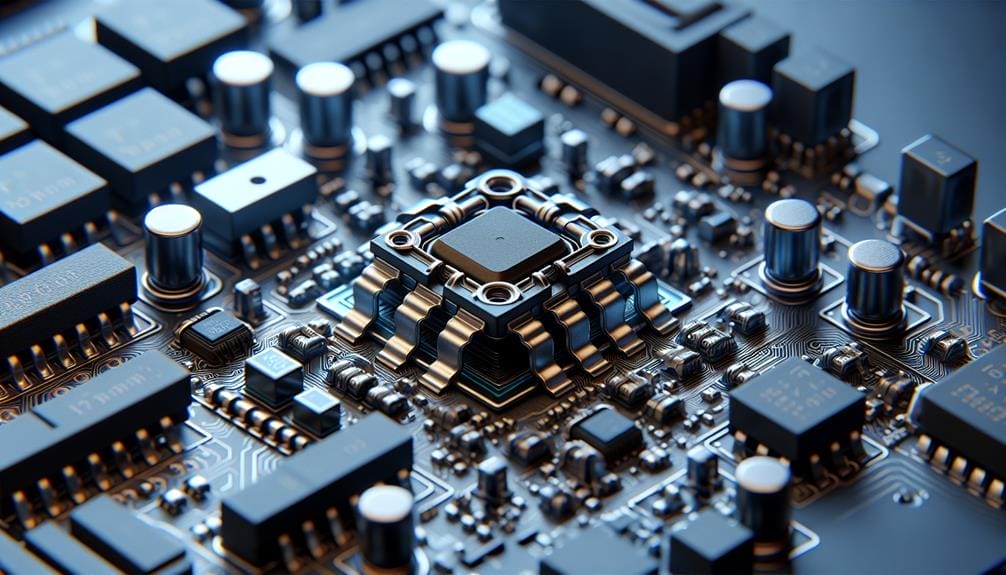
Understanding MOSFETs is crucial for comprehending the intricate workings of modern electronic devices and their role in power management and signal control.
The MOSFET structure consists of a semiconductor substrate, source, drain, gate, and insulating oxide layer. Its operation principles rely on the application of a voltage to the gate terminal, creating an electric field that controls the conductivity between the source and drain.
This voltage-controlled conductivity distinguishes MOSFETs from other transistors. By modulating the gate voltage, MOSFETs enable precise control over the flow of current, making them indispensable in power management and signal amplification.
Furthermore, their high input impedance and low output impedance make them efficient for various applications, from amplifiers to digital switches, showcasing their versatility in modern electronic systems.
MOSFETs in Engineering Applications
The intricate workings of modern electronic devices and their role in power management and signal control are exemplified by the diverse engineering applications of MOSFETs.
In the automotive industry, MOSFETs are crucial for various applications such as controlling electric power steering, managing LED lighting systems, and regulating electric vehicle powertrains. Their ability to handle high currents and voltages makes them ideal for these demanding automotive applications.
Additionally, in renewable energy, MOSFETs play a vital role in solar inverters, where they enable the efficient conversion of DC power from solar panels into AC power for use in homes and businesses. Their high efficiency and fast switching capabilities contribute to the overall performance and reliability of renewable energy systems, further highlighting the significance of MOSFETs in engineering applications.
MOSFETs on Motherboards
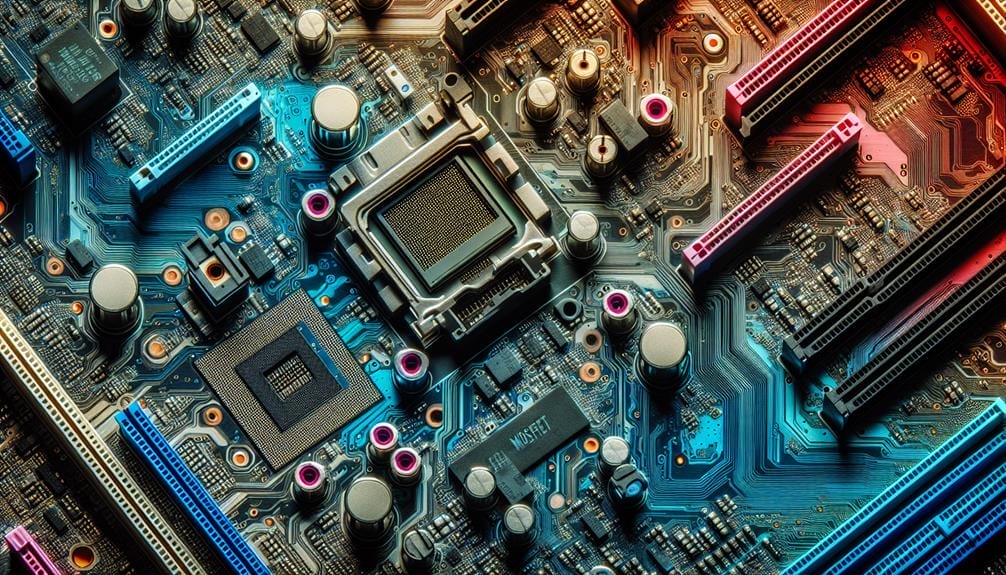
How do MOSFETs on motherboards contribute to the stability and performance of computer systems?
- CMOS Battery Function: MOSFETs are utilized in the CMOS battery circuit to maintain BIOS settings, ensuring that crucial system configurations are preserved even when the computer is powered off.
- Regulation of CPU Voltage: MOSFETs present in the VRMs surrounding the CPU play a pivotal role in controlling and stabilizing the voltage supplied to the processor, thereby influencing its performance and overall system stability.
- MOSFET Manufacturing Process: The precise manufacturing process of MOSFETs determines their efficiency and reliability in managing power delivery to critical components, directly impacting the computer's operational performance and longevity.
Role of VRMs
Continuing our exploration of motherboard components that contribute to system stability and performance, we turn our attention to the pivotal role played by Voltage Regulator Modules (VRMs) in ensuring efficient and precise power regulation for the CPU.
Building upon our previous discussion of the critical functions of MOSFETs in managing power delivery within computer systems, VRMs are essential in converting the mainboard's voltage supply to levels suitable for the CPU.
They consist of MOSFETs, which are crucial in power electronics. The VRMs and MOSFETs work together to regulate and deliver power to the CPU, ensuring that it operates within the specified voltage range.
High-quality VRMs with robust MOSFETs are particularly important for stable overclocking, as they provide the necessary power and support for enhanced performance without compromising system stability.
VRMs and CPU Performance
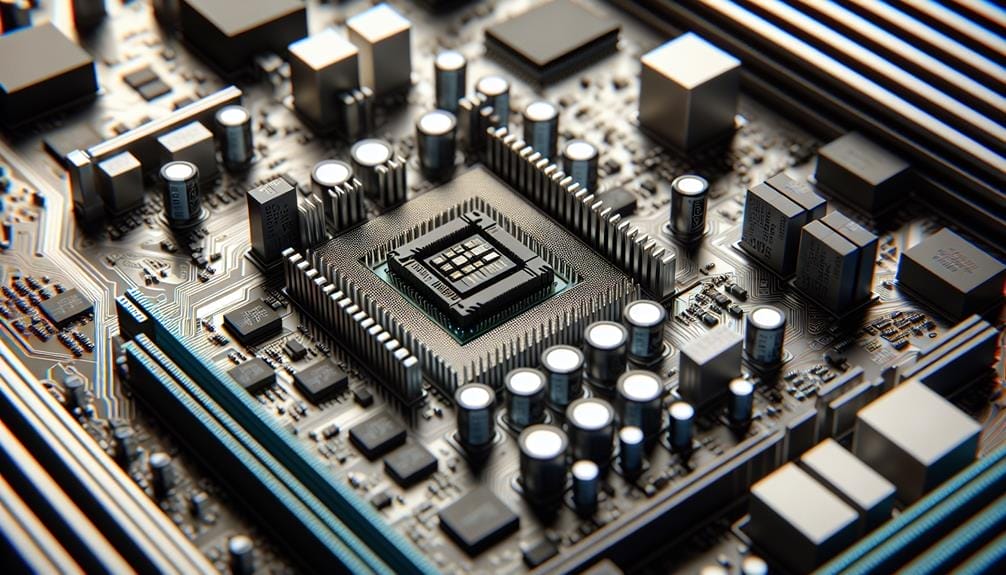
Exploring the intricate interplay of Voltage Regulator Modules (VRMs) and CPU performance unveils the pivotal role of efficient power regulation in optimizing system functionality and stability.
When considering VRMs and CPU performance, several crucial factors come into play:
- Efficient Voltage Regulation: High-quality VRMs with robust MOSFETs ensure precise and stable voltage regulation, catering to the dynamic power demands of modern CPUs.
- Minimized CPU Power Consumption: Well-designed VRMs, coupled with superior MOSFETs, contribute to minimizing CPU power consumption, enhancing energy efficiency, and reducing heat generation.
- Enhanced CPU Performance: The synergy between VRMs and MOSFETs directly impacts CPU performance, enabling stable overclocking capabilities and maximizing the non-overclocked Boost/Turbo frequencies. This ultimately elevates system performance and responsiveness.
Significance of MOSFET Quality
Discussing the significance of MOSFET quality is imperative for understanding its crucial role in ensuring efficient power regulation and stable performance in electronic devices. MOSFET reliability is directly influenced by the manufacturing process, which determines the quality and durability of the component. Here's a table outlining the key factors affecting MOSFET quality:
| Factors | Description | Impact |
|---|---|---|
| Material Quality | High-grade silicon and metal components | Ensures longevity and stable performance |
| Manufacturing Process | Precision in fabrication and assembly | Influences reliability and heat dissipation |
| Thermal Management | Effective heat dissipation mechanisms | Prevents overheating and prolongs lifespan |
Understanding these factors is crucial for selecting motherboards with robust VRMs and MOSFETs, ensuring optimal performance and reliability in electronic devices.
MOSFETs and Overclocking
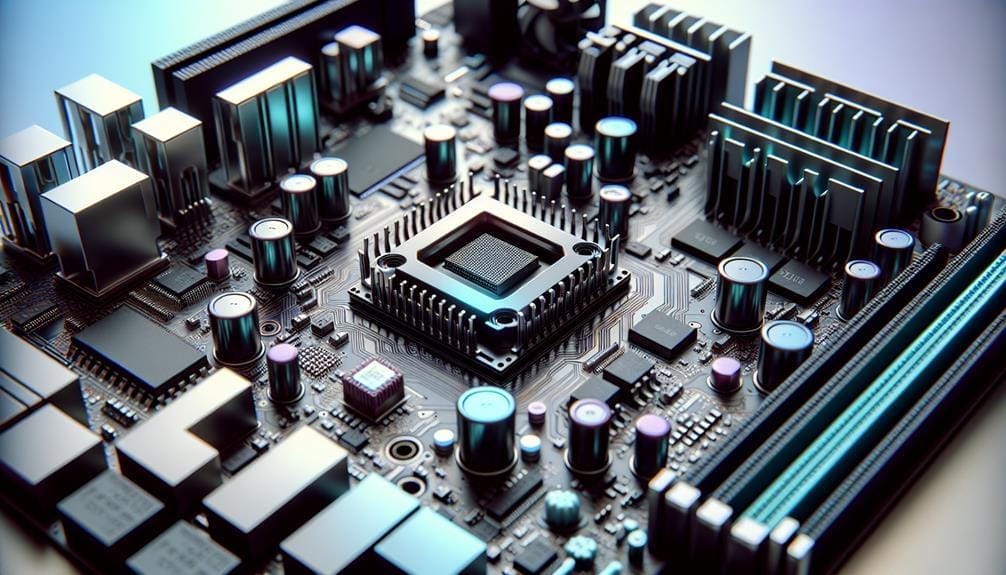
The relationship between MOSFETs and overclocking is fundamental to understanding the intricate interplay between power management and performance optimization in computer systems.
When it comes to overclocking, MOSFETs play a crucial role in ensuring stability and reliability. Here's how they impact the overclocking process:
- Voltage Regulation: MOSFETs are responsible for regulating the voltage supplied to the CPU during overclocking, ensuring that it receives the necessary power without exceeding safe limits.
- Heat Dissipation: During overclocking, MOSFETs can generate significant heat due to increased power demands. Efficient heat dissipation mechanisms are crucial to prevent thermal issues and maintain stable performance.
- Performance Optimization: Well-designed MOSFETs contribute to stable overclocks, enabling users to push their CPUs beyond stock frequencies while maintaining system stability.
Impact on PC Performance
The efficiency and performance of a PC are significantly influenced by the quality and functionality of the MOSFETs integrated within the Voltage Regulator Modules (VRMs) on the motherboard.
MOSFETs play a critical role in maintaining stable power delivery to the CPU. The temperature control of MOSFETs is crucial as excessive heat can lead to performance degradation or even failure.
Analyzing MOSFET failure is essential for preventing potential performance issues. High-quality MOSFETs ensure efficient power management, which directly impacts the overall performance of the PC.
Additionally, proper MOSFET design and functionality contribute to stable overclocking capabilities, maximizing CPU performance.
Therefore, the impact of MOSFETs on PC performance is multifaceted, encompassing temperature control, failure analysis, and efficient power management. Understanding and optimizing these factors are essential for achieving optimal PC performance.
Enhancing CPU Power Management
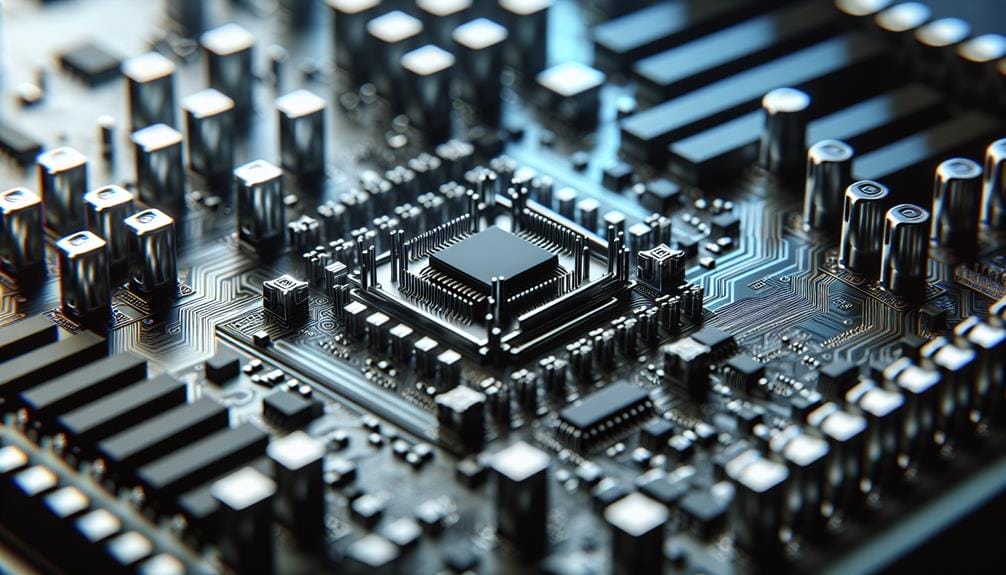
The efficient management of CPU power becomes paramount when considering the critical role MOSFETs play in maintaining stable power delivery and temperature control, thereby directly influencing the overall performance and reliability of a PC.
To enhance CPU power management, the following steps are crucial:
- Implementing advanced power delivery solutions to improve power efficiency and reduce heat generation.
- Optimizing energy consumption by employing intelligent power management algorithms and technologies.
- Integrating high-quality MOSFETs in VRMs to ensure precise voltage regulation and minimize power loss.
Conclusion
In conclusion, Metal-Oxide-Semiconductor Field-Effect Transistors (MOSFETs) are a crucial component in motherboard architecture. They play a pivotal role in power management, signal amplification, and voltage regulation.
Their presence within Voltage Regulator Modules (VRMs) is indispensable for stable overclocking and power efficiency. This ultimately shapes the potential for stable CPU performance.
Understanding the intricacies of MOSFETs and their impact on motherboard functionality is essential for unlocking the full potential of modern computing systems.

